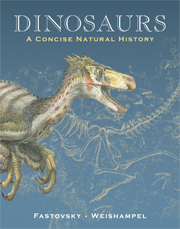Book contents
- Frontmatter
- Contents
- Why a natural history of dinosaurs?
- Dedication
- Part I Reaching back in time
- Part II Ornithischia: armored, horned, and duck-billed dinosaurs
- 5 Thyreophorans: the armor-bearers
- 6 Marginocephalia: bumps, bosses, and beaks
- 7 Ornithopoda: the tuskers, antelopes, and “mighty ducks” of the Mesozoic
- Part III Saurischia: meat, might, and magnitude
- Part IV Endothermy, endemism, and extinction
- Glossary
- Figure credits
- Index of subjects
- Index of genera
7 - Ornithopoda: the tuskers, antelopes, and “mighty ducks” of the Mesozoic
- Frontmatter
- Contents
- Why a natural history of dinosaurs?
- Dedication
- Part I Reaching back in time
- Part II Ornithischia: armored, horned, and duck-billed dinosaurs
- 5 Thyreophorans: the armor-bearers
- 6 Marginocephalia: bumps, bosses, and beaks
- 7 Ornithopoda: the tuskers, antelopes, and “mighty ducks” of the Mesozoic
- Part III Saurischia: meat, might, and magnitude
- Part IV Endothermy, endemism, and extinction
- Glossary
- Figure credits
- Index of subjects
- Index of genera
Summary
Chapter objectives
Introduce Ornithopoda
Develop familiarity with current thinking about lifestyles and behaviors of ornithopods
Develop an understanding of ornithopod evolution using cladograms, and an understanding of the place of Ornithopoda within Dinosauria
Ornith opoda
Ornithopods (ornitho – bird; pod – foot) were the cows, deer, bison, wild horses, antelope, and sheep of the Mesozoic (Figure 7.1, see p. 133). Magnificent herbivores all, they were one of the most numerous, diverse and longest-lived groups in all Dinosauria. From the Jurassic, when they first appeared, until the end of the Cretaceous, when they all went extinct, ornithopods evolved nearly 100 species at present count.
Ornithopods spread all over the globe. They ranged from near the then-equator to such high latitudes as the north slope of Alaska, the Yukon, and Spitsbergen in the Northern Hemisphere, and Seymour Island, Antarctica, and the southeast coast of Australia in the Southern Hemisphere (Figures 7.2 and 7.3). Local conditions in these regions varied widely, so ornithopods lived in quite diverse habitats and in a wide range of climates.
They also evolved a range of sizes: early in their history, ornithopods were generally small (ranging from 1 to 2 m in length); however, later some members of the group attained quite large body sizes (upward of 12 m; Figure 7.4).
We know as much about ornithopods as about almost any other group of dinosaurs: Iguanodon was a charter member of Sir Richard Owen's original 1842 Dinosauria (see Chapter 14). Hadrosaurids (“duckbills”) are known from single bones to huge bonebeds.
- Type
- Chapter
- Information
- DinosaursA Concise Natural History, pp. 134 - 153Publisher: Cambridge University PressPrint publication year: 2009

